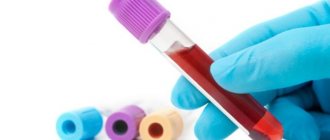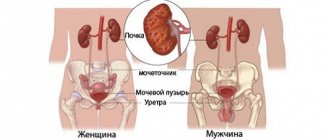Why does hemolysis occur during blood sampling?
: 14 650
A blood test is considered a standard routine test, which any person has to do frequently. The analysis allows us to study the main components of blood, the ratio of blood cells, as well as the presence of pathogens of infectious diseases.
To get reliable results, you need to properly prepare for blood donation: do not drink alcohol or fatty foods on the day before blood collection. If these requirements are not met, hemolysis when taking blood from a vein is very likely.
You need to donate blood from a vein and finger on an empty stomach, in the morning, so that you can eat quickly after the procedure.
But, even if all the requirements are met, the resulting blood may be unsuitable for analysis. Most often, the cause of damage to biological material is blood hemolysis. Let's consider the causes of hemolysis during testing.
Rules for taking blood
A person planning to donate blood for analysis from a vein or finger must ask how to do it correctly.
You need to make sure that some tests require obtaining blood from a vein rather than a finger for a number of reasons:
- When taken from a finger, some of the blood cells degrade and microscopic clots form, making analysis difficult. To avoid repeated blood sampling, it is recommended to take material from a vein;
- To collect blood from a vein, safe disposable vacuum systems complying with international standards are used;
- Some tests cannot be performed on blood taken from a finger prick;
- The process of drawing blood from a vein lasts several seconds. It is safe and painless, which is important when taking samples from small children;
- Highly qualified medical workers are allowed to take blood from a vein.
Rules for taking blood
Reasons for clotting
Hemolysis is the destruction of red blood cells in the blood, releasing hemoglobin. Hemolysis can be physiological (normal) and pathological.
Physiological hemolysis occurs at the end of the red blood cell's life span, which lasts four months. With pathological hemolysis, red blood cells die prematurely.
To prevent clotting, blood collected for testing is stabilized with preservatives.
The causes of hemolysis when taking blood from a finger and a vein lie entirely on the unqualified actions of medical personnel. Either the rules for taking a blood sample for analysis were violated, or the conditions for preserving biological material were not met.
During hemolysis, blood may clot immediately after it is taken, or after a short time, and the analysis will have to be retaken. Private clinics, whose paid services include blood tests, return money if the analysis fails.
Hemolysis during blood sampling from a vein occurs both due to the patient’s fault and due to unqualified actions of personnel.
The patient’s guilt boils down to failure to prepare for blood donation: eating fatty foods directly on the day of blood collection, or the day before. Fats emulsify the blood and cause a change in its colloidal properties. Red blood cells cannot live in such blood and die.
Hemolysis during blood sampling makes it impossible to perform tests and the need to repeat the procedure for obtaining biomaterial for analysis. So, in some cases it is necessary to analyze the level of bilirubin in the blood.
This substance is synthesized from hemoglobin released during the breakdown of red blood cells, that is, hemolysis.
Therefore, hemolysis during blood sampling for bilirubin makes the material unsuitable for analysis: the amount of bilirubin will be obviously overestimated.
Results of Blood Drawing Errors
The fault of the medical staff is as follows:
- Dirty test tube . Traces of materials from the previous analysis remained on the walls of the vessel. It’s good if hemolysis occurs immediately. Otherwise, distorted research results may be obtained;
- A preservative was not added to the test tube, or a solution of inappropriate concentration was prepared;
- High speed of blood sampling. The vacuum caused by rapid filling of the syringe leads to instantaneous destruction of red blood cells;
- Failure to comply with asepsis rules . When transfusing biological material from test tube to test tube, the activity of microorganisms can cause hemolysis;
- Failure to comply with transportation rules . Situations in which blood is collected in one place and examined in another are quite common. If the rules for packaging blood tubes are not followed, and they are subjected to shaking or vibration, which negatively affects blood cells;
- Violation of storage rules. Keeping blood tubes in a vibrating refrigerator contributes to the development of the cause of hemolysis. The destructive effects of direct sunlight and elevated temperatures, or freezing also contribute to the development of the causes of blood hemolysis.
How to avoid
When collecting blood for analysis, it depends a little on the patient. The main thing is to choose a clinic that has a reliable reputation. In case of hemolysis of the sample, it can be taken again.
But few people would be pleased to lose time, and in some situations, money, due to poor quality of service. It’s even worse if hemolysis occurs during blood sampling from an infant or child. The analysis procedure itself, especially from a vein, causes fear in children.
It will be unpleasant for parents to watch the suffering of a baby whose veins are pierced several times.
To prevent such a situation, it is necessary to show interest in the working conditions of medical personnel. You should ask where and when the analysis will be carried out, how it will be transported and under what conditions it will be stored.
To avoid hemolysis of the blood sample being taken, as well as the cost of personal time and money for repeated analysis, it is best to take the procedure seriously and take care of the sterility of the instruments. It is a good idea to have a syringe, sterile gloves and a test tube with you. It is a good idea to personally control the addition of the preservative to the test tube.
Before choosing a private clinic for a blood test, you need to read reviews about its work. Frequent complaints from patients about blood clotting when selected for analysis in a particular laboratory indicate that it is better to go to another institution.
Unscrupulous management of a medical institution may specifically prescribe repeated procedures in the hope of receiving money for them again. In these cases, you must demand a refund and contact another laboratory.
Source: https://SostavKrovi.ru/analizy/svertyvayemost/pochemu-proisxodit-gemoliz-pri-zabore-krovi.html
What is this disease
Blood consists of many components: proteins, platelets, red blood cells, fibrins and others.
It is responsible for the delivery of nutrients and oxygen to all internal organs and tissues. In order to prevent serious blood loss due to vascular damage, a process is provided for the formation of blood clots when tissue factor enters the bloodstream. If this process is disrupted, this indicates the presence of a disease.
Poor blood clotting is associated with a lack of certain enzymes. There is a decreased production of platelets. This pathology is dangerous to human health and life. If the damage to the blood vessels is severe, severe blood loss can lead to death.
Depending on the provoking factor, there may be several answers to the question of what the disease is called:
- If the pathology is associated with a lack of fibrinogen in the blood, then the coagulation disorder is called fibrinopenia.
- When a hereditary factor plays a key role, the disease is usually called hemophilia. Mostly men suffer from this problem.
- The disease caused by a lack of platelets is called thrombocytopenia.
These diseases have similar causes and are characterized by the same symptoms.
Bad blood clotting - what to do?
A problem in which the blood does not clot well is called a bleeding disorder. It is caused by the fact that blood vessels do not normally become blocked when they are damaged.
When everything is fine, when there is bleeding at the wound site, the blood begins to thicken, which prevents large losses. But sometimes this complex mechanism fails, resulting in severe or prolonged bleeding.
When blood does not clot well, this does not always lead to external loss. It can also appear as bleeding under the skin or in the brain.
Causes of poor blood clotting
Blood does not clot well when there are problems with blood clotting factors - the substances in the blood that enable this process. Most of these substances are different proteins. Therefore, many causes are associated specifically with protein defects in plasma (the liquid component of blood).
These proteins are directly responsible for how blood clots, responsible for blocking damaged blood vessels. In some diseases, they may be completely absent or present in too low quantities.
Most of these diseases are hereditary (passed from parent to child through genes).
However, poor blood clotting can be caused by more than just genetic abnormalities. Here is a list of all the main reasons:
- Hereditary disorders. These primarily include hemophilia and von Willebrand disease. Hemophilia is a disease accompanied by poor blood clotting. Von Willebrand disease is a disorder in which the blood factor of the same name (von Willebrand) is insufficient or completely absent, which leads to coagulation disorders;
- Vitamin K deficiency;
- Carcinoma of the liver itself or damage to its cells by cancer from other organs;
- Other liver damage and diseases, most often infectious (hepatitis) and causing scarring (cirrhosis);
- Long-term use of powerful antibiotics or anticoagulant drugs (drugs that are aimed at combating the formation of blood clots);
- The use of drugs called angiogenesis inhibitors, which in some cases are needed to slow and prevent the growth and development of new blood vessels in the body;
- Thrombocytopenia is a condition in which the level of platelets falls below the established norm;
- Anemia is a condition when the level of hemoglobin or red blood cells falls below the established norm;
- Some other disorders not caused by cancer.
The most common causes of blood clotting problems are:
Based on the above, the causes of poor blood clotting can be divided into inherited (passed on by genetics) and acquired. Some of them cause bleeding spontaneously, while others cause blood loss after vascular damage - trauma.
- The most common hereditary bleeding disorders are hemophilia A and B, caused by the deficiency or absence of certain proteins that perform the function of blood clotting, which are included in the group of factors. This disorder causes heavy or unusual bleeding.
- Deficiencies of coagulation factors II, V, VII, X, XII – cause blood clotting problems or abnormal bleeding.
- Von Willebrand disease is the most common inherited bleeding disorder caused by a deficiency of von Willebrand factor (one of the plasma proteins), which helps platelets clump and stick to the wall of a blood vessel.
Some diseases and medical conditions can also cause a deficiency of one or more clotting factors.
The most common causes of acquired bleeding disorders are end-stage liver disease or vitamin K deficiency.
According to the American Association of Clinical Chemistry (AACC), this is because most clotting factors are produced in the liver and some clotting factors are vitamin K dependent.
Learn how to keep your liver healthy.
Symptoms of poor blood clotting
The main sign of a bleeding disorder is bleeding that lasts a long time or is too heavy. The bleeding is usually heavier than usual and for no obvious reason. Other symptoms include:
- unexplained bruises;
- heavy menstrual bleeding;
- frequent nosebleeds;
- stopping bleeding from minor wounds for too long.
What to do if blood doesn't clot well
If you have the symptoms listed above, you should definitely consult a doctor and undergo an examination. At the moment of bleeding itself, first aid should be provided in accordance with general recommendations, based on the location and type of injury. If necessary, call an ambulance.
Diagnostics
To diagnose blood clotting, the doctor first reviews the patient's medical history. To do this, he will ask questions about your health problems and medications you are taking. You need to answer something like this list of questions:
- What are the accompanying symptoms?
- How often does bleeding occur?
- How long does the bleeding last?
- What were you doing before the bleeding started (for example, were you sick, took medications)?
Basic tests to check blood clotting :
- A complete blood count to check the blood loss at the time the test was taken and the number of red and white blood cells.
- Platelet aggregation test, which shows the extent to which platelets are able to adhere to each other.
- Measuring bleeding time to see how quickly blood vessels clog after pricking a finger with a feather.
Treatment options for poor blood clotting
Treatment for a bleeding disorder is based on the causes that cause it. If possible, the diseases that caused the disorder, such as cancer or liver disease, are immediately treated. Additional treatments include:
- Taking vitamin K by injection;
- Drugs aimed at improving clotting function;
- Transfusion of frozen donor blood plasma or donor platelets;
- Other drugs, including hydroxyurea (Droxia, Hydrea), and oprelvequin (Neumega) to treat platelet-related disorders.
Treatment of consequences caused by blood loss
Iron supplements
If there is significant blood loss, the doctor may prescribe medications containing iron to replenish its amount in the body.
Low iron levels can lead to iron deficiency anemia, which is accompanied by feelings of weakness, shortness of breath and dizziness. One of the most common and accessible drugs in this case is Hematogen.
In addition to treatment with iron supplements, blood transfusions may be required.
Blood transfusion
During this procedure, as most people know, blood loss is compensated with the help of donor blood. Donated blood must match your blood type to prevent complications. This procedure can only be performed in a hospital.
Complications of bleeding disorders
The best treatment results can be achieved if treatment is started as early as possible. Complications can occur if it is started too late or after heavy bleeding.
Common complications of bleeding disorders:
- bleeding in the brain;
- bleeding in the gastrointestinal tract;
- bleeding and joint pain.
Loading…
Source: https://zdorovko.info/ploxo-svorachivaetsya-krov-prichiny-simptomy-lechenie/
What herbs thin the blood and lower blood pressure?
Few people think that health in general depends on the quality of blood. It is she who nourishes all organs, supplies them with oxygen, useful elements, hormones and many other compounds. The speed of delivery of substances depends on the consistency of the plasma: the thicker the blood, the slower its flow, and, accordingly, all reactions in the body. The high viscosity of biological fluid leads to a slowdown in metabolic processes, a lack of oxygen in tissues (hypoxia), and the accumulation of decay products in cells. Dysfunction of blood flow leads to disturbances in the functioning of the heart, causing headaches, general weakness, and increased blood pressure. Doctors prescribe medications that normalize health and recommend adherence to drinking and dietary regimens. An alternative to medications can be herbs that thin the blood and lower blood pressure. They must be taken with caution so as not to cause even more significant harm to the body.
Effect of herbs on blood pressure
Many herbs have a blood pressure (BP) lowering effect. But they also have secondary (side) properties. Therefore, when choosing which herbs to take for blood pressure, it is necessary to take into account possible concomitant effects, and depending on this, draw up a plan for maintenance therapy.
Herbs with targeted effects on blood pressure
The following herbs reduce blood pressure (systolic and diastolic):
- small periwinkle (all parts of the plant except the roots are used in tinctures);
- astragalus (infusions or decoctions are prepared from stems or petals);
- marsh cudweed (use a decoction of the leaves).
As a rule, all these herbal remedies act specifically to lower blood pressure without causing significant side effects on the body. In pharmacies you can buy ready-made preparations (collections) based on them and take them according to the instructions to normalize blood pressure.
Plants for lowering blood pressure and thinning the blood
Herbs and plant-based preparations that not only reduce blood pressure, but also speed up blood flow, are often used when there is a high risk of blood clots. They are indicated for use by patients with stage 2 hypertension and higher to prevent the formation of blood clots and combat the development of tissue hypoxia.
Herbs for thinning the blood are prepared and taken strictly according to the instructions, otherwise you can only worsen your health condition.
White willow bark: for 1 large spoon of dry ingredients you need 1 cup of boiling water. Bring the mixture to a boil and cook for 15 minutes. Remove from heat and leave for half an hour. The strained medicine is taken three times a day, 2 tbsp. before meals for 1.5 weeks.
Yellow sweet clover: pour a tablespoon of herb into 500 ml of boiling water and leave for 2 hours. For high blood pressure, take 100 ml three times a day for a month.
Dioscorea Caucasian: you will need 0.5 liters of vodka and 60 g of finely chopped plant roots. The tincture is set aside for 2 weeks in a dark place, the container is shaken daily. They thin the blood with this remedy by taking 20 drops daily along with water three times a day for 3 weeks. The course is repeated after a break of a week.
Meadowsweet: per liter of cold water you will need 2 large spoons of dried flowers, which are poured for 12 hours. The strained medicine is taken 250 ml three times a day between meals. Blood thinning is observed 2 weeks after the start of treatment with the drug.
Horse chestnut: 30 g of chestnut peel is poured into 250 ml of vodka and left for half a month. Take the medicine 30 drops after any meal for a month.
Hazel: brew 2 tbsp in 0.5 liters of boiling water. dry leaves until completely cool. Take 150 ml 3 times for hypertension. in a day. The course of treatment is 2 months.
Lungwort: 2 tbsp. plants are poured with 0.5 liters of boiling water and left until cool. The strained product is drunk three times a day, 250 ml after any meal.
Blood-thinning tinctures and decoctions should be treated with caution. Before starting therapy with folk remedies, it is better to consult a doctor.
Means for normalizing blood pressure
Herbal tinctures prepared according to folk recipes, or plant-based preparations purchased at the pharmacy chain, should be taken by people with high blood pressure daily. They help strengthen blood vessels and normalize heart function. Plants provide a long-term and stable decrease in pressure:
- laurel;
- viburnum seeds;
- dill seed;
- cottonweed;
- motherwort;
- mistletoe;
- hawthorn.
All herbs provide long-lasting results, but for maximum effect, therapy with such herbs should be carried out for at least a month and, if the result is successful, repeated periodically.
Herbs with diuretic effect
Such plants are suitable for patients with constantly high blood pressure and certain renal pathologies. For example, horsetail relieves swelling and normalizes blood pressure, but you need to make sure that it does not increase your heart rate, otherwise you should stop taking it. Silver birch has a beneficial effect on kidney function. Bearberry is added to medications if blood pressure rises due to kidney failure.
In any case, the use of these plants is permitted only after consultation with a doctor, since all of them can negatively affect the health of people with severe renal dysfunction.
What herbs are allowed for heart disease?
When high blood pressure is combined with heart pathology, self-medication is dangerous. Hypertensive patients can be treated with the following remedies after medical consultation:
- red hawthorn;
- motherwort;
- valerian;
- pomegranate;
- garlic with mint;
- bulb onions;
- red clover;
- rose hip.
These plants and herbs provide a hypotensive effect, reducing the risk of exacerbation of heart disease. You can buy drugs based on them in pharmacies and take them according to the instructions or with the permission of your doctor.
Recipes for folk remedies
Many plants can lower blood pressure, normalize health, and thin the blood. But some recipes have proven themselves best and are therefore widely used among hypertensive patients.
Garlic infusion
Garlic is ground in a meat grinder and poured with vodka in a ratio of 1:3. The product must be kept in a place where there is no direct sunlight for 2 weeks. Every 2-3 days the medicine needs to be shaken.
Lemon-honey mixture
You can prepare a fairly effective remedy from lemon juice and honey syrup in equal proportions. The contents are thoroughly mixed, and the product is taken 1 tbsp. every day before bed. In addition to thinning the blood, this medicine helps strengthen the immune system and prevent infection with influenza and ARVI.
Herbal collection
To prepare the medicine, you need to mix 1 tsp. each of the herbs:
- mountain arnica;
- sweet clover;
- sagebrush;
- spiraea.
You will need a glass of hot water per tablespoon. The collection is poured overnight (it is advisable to use a thermos), and in the morning it is filtered, divided into 4 equal parts, and taken throughout the day before meals. The duration of treatment is 1 month.
Important! You cannot prepare the tincture several days in advance, as it will lose its medicinal properties. It is necessary to infuse the herbal mixture again daily.
Ginger
Fresh ground ginger root is mixed with 1 tsp. green tea with a pinch of cinnamon added. The mixture is poured with 2 tbsp. hot water and infuse until completely cooled. The strained drink is diluted with lemon juice (from half of 1 citrus) and honey if desired. The medicine must be divided into 4-5 parts, which are taken throughout the day, regardless of meals.
Any of the remedies are quite easy to prepare and just as easy to take. An excellent addition to treatment would be diet, regular walks and simple exercise, as well as quitting smoking and alcoholic beverages.
Why blood clotted during analysis - reasons
Your blood clotted during the test your doctor sent you for. You know that blood is an important material that allows us to identify many harmful bacteria (and not only) that provoke the development of inflammatory processes in the body. But sometimes the blood test taken is invalid, the reason for this is its clotting, but why does it happen?
Failure of blood clotting after taking it for analysis is especially unpleasant if the analysis is paid for or a quick result is needed. In some cases, the delay in obtaining the result may have a negative impact.
Lack of preparation for the test may cause the blood to be unsuitable for testing.
Almost every person, when an illness appears, is faced with a blood test from a vein. Indeed, blood from a vein allows us to learn about most of the processes occurring in the human body.
Thanks to this material, the doctor is able to immediately find out by deciphering the analysis result whether there is an inflammatory process in the body and what treatment methods will be more effective in this situation.
But in order to obtain accurate information, blood must be donated in accordance with all rules.
You should prepare for the test a couple of days before the appointed day. During this period, foods containing a high percentage of fat, as well as alcoholic beverages, are excluded from the diet. When donating blood from a vein, a person must have an empty stomach.
If these requirements are not met, there is a high risk of not only obtaining an incorrect result, but also the inability to conduct a blood test due to hemolysis.
It is worth knowing that hemolysis - blood clotting - is a natural process that necessarily occurs with every red blood cell, the existence of which is about 120 days. After this period of time, every red blood cell in a person’s blood ends its existence by hemolysis.
What hemolysis is is often learned by the patient only when it turns out that the analysis failed due to blood clotting.
Hemolysis is a natural process in which red blood cells undergo destruction, during which hemoglobin is released. It is this process that provokes blood clotting.
You can avoid such troubles with the analysis by adhering to the preparation rules applied before taking the analysis.
And although most often the causes of hemolysis are hidden in improper preparation for the test, there are other reasons that can make blood unsuitable for testing.
Blood clotted during analysis - possible causes
Even if all the requirements were met before taking the test, this does not mean that there are no reasons why the blood would clot. In fact, there are an impressive number of them. This means that it will not be possible to tell once why the blood taken from a vein for analysis has clotted. Since many reasons can provoke such a reaction:
- Poor tube processing. Sometimes the reasons why blood clots may be hidden in traces of blood that was previously in a given test tube. Even minor traces of it can provoke hemolysis;
- Blood sampling was carried out in an accelerated manner. If blood is taken from a vein in literally a few seconds, then the strong vacuum obtained for this reason provokes instant hemolysis. Therefore, in this case, it is not even worth wondering why the immediately taken blood clotted;
- Low amount of preservative. To prevent the clotting process from starting in the analysis of blood taken from a vein, a special preservative is added to it, this helps preserve the blood for research. But for the blood to clot even in the presence of this preservative, it is enough to incorrectly calculate its dosage and add a significantly smaller amount than required;
- Violations of antiseptic rules. The reasons may also be hidden in the transfusion of blood from one test tube to another. Often, when analyzing blood taken from a vein, the blood is transfused into another tube. And if one of the test tubes was not previously sterilized, then the reason why the blood clotted may be precisely this failure to comply with the rules for sterilizing test tubes;
- Lack of proper transportation conditions. Sometimes the workers involved in transporting them to the laboratory are to blame for an invalid analysis. This happens more often in clinics, where tests for research are transported to other medical centers;
- Storage violations. In order for the blood to clot, it is enough to shake the flask or place it, for example, on the refrigerator, this will provoke hemolysis;
- Temperature conditions. Blood should not be frozen or kept in sunlight, as this will cause it to change, after which it will become unsuitable for research. It is also impossible to store at room temperature, this also applies to one of the common causes of blood hemolysis.
Despite the existing reasons, it is easy to reduce the likelihood of hemolysis. You just need to adhere to the rules, starting with preparation for the test, and subsequent actions performed with the resulting blood sample.
Source: https://testanaliz.ru/krov-svernulas-pri-analize-prichiny
Varicose veins
Varicose veins (a simplified name for varicose veins) is a pathological process that leads to damage to the veins.
With this disease, so-called nodes are formed, which are aneurysal-like (similar to an aneurysm - protrusion of the walls of the arteries due to their thinning) local expansions.
Varicose veins are characterized by an increase in the diameter of the lumen and thinning of the venous wall itself.
Varicose veins most often affect the vessels of the legs, but sometimes manifests itself in other organs. Since the arms are constantly exposed to stress and, in addition, are most often lowered, the blood flow to them is increased. This gradually leads to stagnation. Initially, the appearance of dilated veins occurs on the hands.
Sometimes the disease is accompanied by painful sensations. This occurs due to impaired functioning of the vascular valves. Violation of their performance leads to an increase in blood pressure, as a result of which, in turn, the vessels begin to twist. It is this process that can cause severe pain. Therefore, you should not wait for the disease to develop, because at the initial stage it is much easier to treat.
Why blood clotted during analysis - reasons - About tests
Ekaterina Kaligina, March 16, 2019
Nutritionist, Therapist, Pulmonologist
Hello. Probably because of the food. Don't worry, there may be technical errors.
Yulia Maryashina, March 16, 2019
Obstetrician, Gynecologist, Pediatrician
Hello. This happens when the storage of the material is improper (poor quality test tube)
Retake the test calmly.
Natalya Bykova, March 16, 2019
Infectious disease specialist, Hepatologist
Good evening. Don't worry, it happens and it doesn't always depend only on you. Perhaps technical things.
Inna Zhikhoreva, March 16, 2019
Dermatologist, Venereologist, Trichologist
Hello, Natalia!
The reason is definitely not the seeds. Most likely, the blood stabilizer in the test tube was defective. Unfortunately, this happens.
Aida Karabekyan, March 16, 2019
Pediatrician, Therapist
Hello! This happens often. But still, before the operation, it is advisable to take a CBC with platelets, determining the bleeding and coagulation time, and a coagulogram. Sunflower seeds would have no effect. Most likely laboratory errors. Don't worry!
Tatyana Fedotova, March 16, 2019
Gynecologist, Cardiologist, Venereologist
No, it's not because of the food. Probably the blood was taken slightly incorrectly or the tube was shaken (if it was a vacuum tube)
Ivan Denishchuk, March 16, 2019
Andrologist, Urologist
Not because of the seeds. Don’t worry, there may be problems with the correct collection of material, its storage and transportation. Also, this is not because you have an infection. Do not worry.
Nina Izvozchikova, March 16, 2019
Gastroenterologist, Infectious disease specialist
Hello! Don’t worry. The blood clotted not because you ate the day before. These are technical errors. Calmly retake the tests.
Pavel Alexandrov, March 16, 2019
Infectious disease specialist, Hepatologist
Hello! No, most likely it was just a low-quality test tube, don’t worry, just retake it.
Natalya Belyakova, March 16, 2019
Pediatrician, Therapist, Masseur
Good afternoon, I’ve seen situations like this hundreds of times and it has absolutely nothing to do with it. Laboratory error and that's it.
Regina Abdullina, March 17, 2019
Cardiologist, Therapist
Hello, it all depends on the blood transportation and storage, don’t worry about retesting.
Source:
Why does hemolysis occur during blood sampling?
: 14 117
A blood test is considered a standard routine test, which any person has to do frequently. The analysis allows us to study the main components of blood, the ratio of blood cells, as well as the presence of pathogens of infectious diseases.
To get reliable results, you need to properly prepare for blood donation: do not drink alcohol or fatty foods on the day before blood collection. If these requirements are not met, hemolysis when taking blood from a vein is very likely.
You need to donate blood from a vein and finger on an empty stomach, in the morning, so that you can eat quickly after the procedure.
But, even if all the requirements are met, the resulting blood may be unsuitable for analysis. Most often, the cause of damage to biological material is blood hemolysis. Let's consider the causes of hemolysis during testing.
Why does blood clot during a general blood test?
Blood clotting is an important indicator of human health.
If the degree of coagulation is normal, blood circulates evenly throughout the body, supplying the organs with oxygen and nutrients, and any small open injury or damage to the epidermis heals quickly. If the plasma is too thick or thin, a person risks a number of serious diseases - potentially life-threatening.
Norm and deviations
In order to determine blood clotting indicators in a particular person, it is necessary to conduct a laboratory analysis of biological material. In a normal state, the density of blood is concentrated at 1048-1066 units, and the density of the plasma in the composition is also important. Its normal values are 1029 – 1034. Arterial blood is less dense than venous blood.
The viscosity itself depends on the ratio of proteins and red blood cells in the liquid tissue. In cases with deviations, several scenarios are possible - the blood becomes too thick or thin.
Thrombophilia is a bleeding disorder with excessive plasma density, along with blood cells.
The disease is dangerous because it increases the risk of blood clots; a person is susceptible to diseases such as thrombosis or varicose veins.
If deviations are not controlled, the risk of strokes and heart attacks increases, and the load on the liver and kidneys increases, causing chronic problems with these organs.
A deviation in which the blood is too thin is called hypocoagulation; it can threaten a person with large blood loss with minimal trauma or damage.
Source: https://crbkukmor.ru/krov/pochemu-krov-svernulas-pri-analize-prichiny.html
no blood comes from the vein
I'm 32 weeks now, tried to donate blood today
I must say that the nurse doesn’t seem very experienced either (my aunt is about 50 years old)
I searched and felt the veins for a very long time before injecting, although others quickly cope with this
In general, I already have several holes in the vein there, but there is no bruise
They really have a different method - you can’t squeeze your hand afterwards, like we do.
They took it with half a kick and I didn’t feel anything
Trending
“So nice!”: Nastya Kamenskikh became an honorary friend of the Women’s Champions League
“Malakhov and Borisov will seize on this story”: Sadalsky joked about the similarity with Prigozhin
Hit parade of star gifts for March 8th
The heroine of the series "Sex and the City" wants to run for mayor of New York
“You can see it in my face”: Natalya Rudova visited Disneyland for the first time
about the project
All rights to materials posted on the site are protected by copyright and related rights legislation and cannot be reproduced or used in any way without the written permission of the copyright holder and placing an active link to the main page of the Eva.Ru portal (www.eva.ru) next to with the materials used.
The editors are not responsible for the content of advertising materials. Certificate of registration of mass media El No. FSot May 22, 2009 v.3.4.178
We are in social networks
Why did blood clot during analysis?
A general blood test is one of the most common methods of laboratory diagnostics necessary for assessing the amount of hemoglobin, the number of constituent elements - red blood cells, platelets, leukocytes, etc. Taking a sample of biological material (venous or capillary blood) is carried out by qualified specialists in compliance with the necessary set of aseptic measures and antiseptics.
To successfully conduct the study and obtain the most reliable results, the patient also needs to adhere to simple rules - avoid drinking alcohol and fatty foods, and donate blood on an empty stomach. What to do if, despite the fulfillment of the requirements on the part of the patient and the medical professional, the collected blood sample has clotted and cannot be used for analysis?
In this situation, there is no particular cause for concern - this phenomenon is quite common in medical practice under the name hemolysis. In this article, we will provide our readers with information about what reasons lead to the unsuitability of a biomaterial sample for research, what to do if blood clots during a blood test and how to insure yourself against such a situation.
How to submit biological material correctly?
In the absence of appropriate preparation before testing, the resulting sample may become unsuitable for study.
In laboratory diagnostics, blood from a vein is most often used - it is this material that provides practitioners with more detailed information about the biochemical processes occurring in the human body.
Based on the final analysis data, the attending physician can accurately diagnose the pathological process and decide on the tactics of subsequent treatment measures.
However, to obtain accurate results, the patient needs to donate blood after following the relevant rules.
You should start preparing for the biomaterial collection procedure three days before the appointed time:
- The consumption of alcoholic and sweet carbonated drinks is prohibited.
- Fatty, spicy and fried foods are excluded.
- Smoking, psycho-emotional stress and physical activity are limited.
A sample of biomaterial is taken in the morning - from 8.00 to 11.00. It is advisable for the patient to have dinner on the eve of the study no later than 19.00, and it is necessary to refuse breakfast - it is allowed to drink a glass of purified water without gas. The child can be fed 2 hours before the procedure.
It is the hemolytic reaction, which is based on the physiological destruction of red blood cells, that most often leads to the impossibility of performing an analysis
Can't take blood from a vein?
Ask experienced hepatitis specialists for advice.
Share your experience.
Can't take blood from a vein?
19 Sep 2011, 19:35
My husband went for his first blood draw today (2 weeks) and 3 different nurses couldn’t take blood from his vein! They pricked and picked about 7 times - nothing! His veins are normal, this has never happened before. At first, when I called, I thought the inexperienced nurse had gotten caught, she said, ask for another one! I demanded nothing again!
Well, how can this be?
They said he was dehydrated, gave him something to drink, an hour later they started taking him again, nothing again. But he drinks all day every day, how can he be dehydrated?
Now he has to go again, he’s already afraid of anger.
Harvoni (ledipasvir/sofosbuvir), November NO HEPATITIS!
Re: Can't take blood from a vein?
19 Sep 2011, 19:39
You need to play sports, don’t use drugs
take a needle with a larger diameter
After four weeks PCR minus
Re: Can't take blood from a vein?
19 Sep 2011, 20:16
Harvoni (ledipasvir/sofosbuvir), November NO HEPATITIS!
Re: Can't take blood from a vein?
20 Sep 2011, 20:18
Otherwise, they, especially the young ones, are afraid to tighten the tourniquet normally, they don’t palpate the vein and, accordingly, they play with darts.
It happened once, I took three tests at once, they were only able to take the first one, barely any blood flowed at all, and I did not give permission for a second puncture.
Although they are now taking at least 3 new methods from a vein if.
-1 Vacuum cap through cartridges
-2 Vacuum cord through cartridges
-3 Syringe cap and cartridges
-4 The old-fashioned syringe and at random (haven’t seen it for a long time)
By the way, if after the tests hemotomes appear at the injection sites, let them bandage for 30 minutes.
I'm not a machine, not men, I'm more!
Re: Can't take blood from a vein?
20 Sep 2011, 21:03
copegus1000. 12 weeks (-).
copegus1400. 1 month
IL 28B-CT. 45 WEEKS ULTRAMINUS.
PVT completed 70 weeks.
6 months after PVT PCR -
Re: Can't take blood from a vein?
20 Sep 2011, 21:30
Re: Can't take blood from a vein?
20 Sep 2011, 21:56
Re: Can't take blood from a vein?
20 Sep 2011, 22:27
Re: Can't take blood from a vein?
21 Sep 2011, 03:05
My husband went to another office of the same clinic (this one, where they couldn’t take blood much more than us), and there a man took it without any problems, but on his wrist, because... looked at both hands in the fold and said that it wouldn’t fit there, because... They've already messed around there so much that they won't risk it next time.
By the way, the blood is not thick, but on the contrary, because... I remember that in the tests I didn’t like his platelets indicator (what, by the way, are platelets?), because... only 138, but it should be, which threatens poor clotting during bleeding.
I hope this doesn't happen every time.
Harvoni (ledipasvir/sofosbuvir), November NO HEPATITIS!










